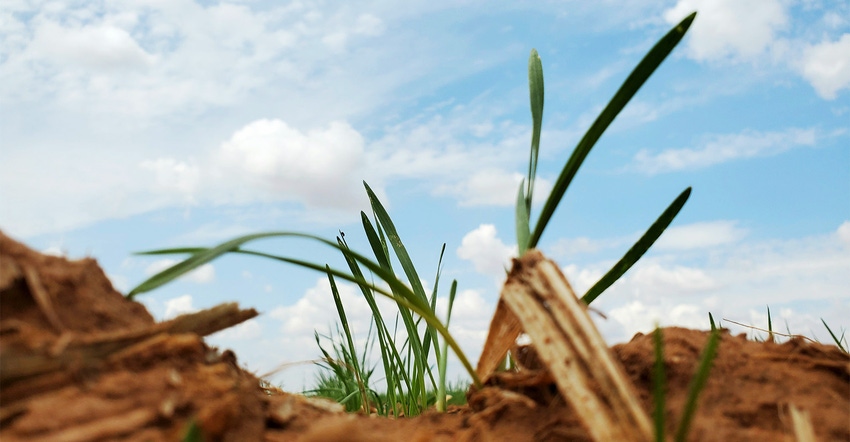
Selecting the appropriate variety to match purpose, management system, and region is one of the most critical factors Texas wheat farmers face every fall.
“At Texas A&M, we are working to provide the best information we can to help farmers make the right decisions,” says Texas AgriLife Extension Small Grains Specialist Fernando Guillen Portal, College Station. “Variety selection is one of the most critical aspects of wheat production, but we have no general rule of thumb that works for every farm.”
Guillen says farmers consider multiple issues in wheat planting decisions.
“At Texas A&M, we spend a lot of time gathering data from years of evaluations to make the best recommendations for different regions. Those recommendations go into the annual Picks list of recommended wheat varieties (http://varietytesting.tamu.edu/wheat/).”
Guillen says those recommendations are based on evaluations of major criteria, including grain yield, resistance to stripe rust, leaf rust, and tolerance to insects such as the Hessian fly. He adds that quality factors for end-use — milling and baking characteristics — also are important concerns.
“Last, but certainly not least, is performance consistency,” Guillen says. “We look at how a variety performs across different locations across regions, but we also consider how it performs over multiple years.
“Growing conditions in Texas are very unpredictable from year to year. I came to Texas in March 2020, and the first thing that impressed me was how variable conditions in Texas are. Consistency of performance across years constitutes an important factor to consider.”
Variety trials
Every year, uniform variety trials across Texas collect variety data from representative locations within wheat-growing regions.
See, Rain delays early wheat seeding in Oklahoma
“That’s how we get the Picks list. We are also evaluating new commercial varieties for Texas, but are reluctant about making recommendations based on only one-year data, we need at least three years of evaluation.”
Planting date
Guillen says planting dates in Texas vary by region and end-use. Producers in the four distinct regions—the High Plains, Rolling Plains, Blacklands, and South Texas—follow different planting deadlines for either dual-purpose or grain production.
“Growing conditions differ substantially among those four regions, and planting date is defined by those conditions.”
Farm specifications
He adds that producers also must consider the typical growing conditions of their farms. “Water availability during the season is a crucial factor,” Guillen says. “Temperature patterns during the reproductive stage is also crucial. Across Texas, every year we face the likelihood of freezing temperatures during wheat’s reproductive stage. Freezing temperatures can affect yield potential. A freeze that lasts several hours may cause significant pollen injury, reduce pollination percentage, and may have a significant impact on yield.
“Famers should learn as much as they can about weather patterns in their areas to avoid freezing temperature during the reproduction stage.”
End use
Cropping systems and specific farm management practices also influence planting date. “If farmers plant for grain only, typical planting date runs from October into November. For dual-purpose wheat, producers want to plant as early as possible to get an extended growing period for grazing.
“Typically, dual-purpose wheat is planted earlier, in September,” Guillen says. “We have tradeoffs and two major risk factors — water availability/soil temperature — with early planting.
“In Texas, September temperatures are still warm. Producers might consider planting a bit deeper than usual to avoid warmer soils. However, with current varieties, deep planting is not recommended,” Guillen says. “Most wheat varieties are semi-dwarf, and the genes that control semi-dwarfism, related to reduced coleoptile length, prevent deeper planting.”
Guillen says producers might choose to increase seeding rate, but emergence is never 100%, so thinner stands are still possible.”
Dry weather at planting time caught many Blacklands’ farmers last fall, Guillen says. “La Nina prevented many from planting until November. Some planted in the dust, with no moisture. Depending on the location, some succeeded; others made nothing.”
Pest management
Wheat farmers also must consider seasonal diseases and pests. “With early planting, plant hosts that carry pathogens will be available and may create significant problems.”
Guillen recommends, regardless of purpose, that farmers employ proper pre-plant operations to eliminate volunteer wheat and seasonal weeds that host diseases and insects.
“Planting date is important,” he says. “For dual-purpose wheat, producers want to plant as early as possible to get extended grazing in late fall and early spring. If they plant for grain, they want to wait a bit longer to plant and avoid those early problems.”
Grain or Grazing?
He adds that producers will be watching both the wheat and the cattle markets as they make planting decisions. Wheat looks good, now. “It will be interesting to see how trends in the cattle market will affect planting decisions,” Guillen says.
The market also could affect production decisions. “The price of wheat (on September 16) was $6.70,” he says. “That’s an attractive market and it would be understandable for farmers to consider trying to maximize yields and profit. But cost is a factor. As the price of wheat goes up, so does the price of inputs, especially fertilizer.”
Fertilizer costs
He says the price of phosphorus, for instance, is high, and farmers might want to consider changing application technique rather than increasing the rate.
“Phosphorus has little mobility in the soil. The general recommendation has been to apply phosphorus pre-plant but applying at planting could be more efficient.”
Producers might also consider nitrogen application timing. The typical practice is to apply one-third of the nitrogen recommendation at planting and two-thirds topdressed. Tweaking that formula, Guillen says, even applying 100% as top-dress, might work in some cases, but producers should look hard at efficiency.
Pest control will be another cost factor, Guillen says. “Herbicides and fungicides are not as expensive as fertilizer, but we recommend that producers be as efficient as possible with weed and disease control.”
He recommends integrated weed management options when possible. Crop rotation, care when moving equipment, and eliminating volunteer wheat decrease pressure on the herbicide.
“Rotate properly with crops and chemicals,” he says. “Use the right product at the right time and at the right rate. The most crucial factor is timing, considering the target plant’s growth stage and the weather conditions at application.”
Adverse weather also could result in herbicide drift, reduced efficiency, and injury to non-target crops.
Scout disease
Portal recommends scouting for disease infections. “When disease symptoms appear, make decisions on the most effective and inexpensive control.”
Guillen says much of the state is dry and expects some farmers, especially those committed to dual-purpose wheat, will plant in the dust.
After producers select the best varieties, follow planting date recommendations, and do all they can to manage pests, they still face factors they can’t control.
Next article? "Rain delays early wheat seeding in Oklahoma." Stay tuned!
About the Author(s)
You May Also Like






